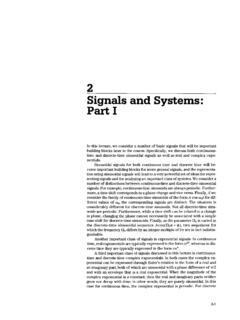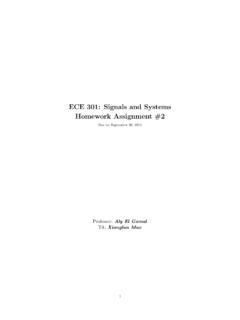Transcription of EC6303 Signals and Systems Department of ECE 2016-2017 ...
1 EC6303 Signals and Systems Department of ECE 2016-2017 UNIT I -CLASSIFICATION OF Signals AND Systems part A 1. What are the major classifications of Signals ? Signals are classified as Continuous time (CT) and discrete time (DT) Signals . Both CT and DT Signals are further classified as Deterministic and Random Signals , Even and Odd Signals , Energy and Power Signals , Periodic and Aperiodic Signals 2. With suitable examples distinguish a deterministic signal from a random signal . Define a random signal .(May 2013) Deterministic signal : A signal which can be modeled (represented) by a mathematical equation.
2 Example: cosine signal Random signal : A signal which cannot be modeled by a mathematical equation is called random signal . Example: Speech signal 3. Define energy signal and power signal .(April 2015) A signal x(t) is said to be energy signal if , Energy is finite 0 < E < and average power is zero P=0 Where E = energy and P = Average power < and energy is infinite A signal x(t) is said to be power signal if power is finite 0 < P E = where E = energy and P = Average power 4. Give the mathematical and graphical representation of unit step sequence.
3 5. Give the mathematical and graphical representation of unit ramp signal . 6. What are periodic Signals ? Give example. A signal x (t ) is said to be periodic if x(t) x(t T ) for all t . The smallest value of T for which the condition is satisfied is called the fundamental : sinusoidal Signals 7. What is odd signal ? Give example. A signal x ( t ) is said to be odd signal if x (t ) = x( t) x ( t ) .Example: x (t ) Asin t 8. State two properties of unit impulse function. (Dec2014) 1. (t) is the limit of graphs of area 1, the area under its graph is 1.
4 (t)peak response at origin. 9. Define symmetric and anti symmetric signal . Symmetric signal :It is a even signal ,A signal x (t ) is said to be symmetric signal if x ( t ) = x (t ) . Example: x (t ) Acos t Anti symmetric signal : Dhanalakshmi Srinivasan College of Engineering and Technology 1 EC6303 Signals and Systems Department of ECE 2016-2017 A signal x (t ) is said to be anti symmetric signal if x (t ) = x ( t ) . Example: x (t ) Asin t 10. Verify whether x(t) Ae atu(t) , a 0 is an energy signal or not. x(t) Ae atu(t) , a 0 T 2 T 2 e 2a t T A 2 : Energy lt x(t) dt lt Ae a t dt lt A2 Joules T T T 2a 0 2a T 0 1 T 2 1 e 2at T 0 Watt power lt x(t) dt lt A2 T 2T T 2T 2a T 0 Energy is finite, Power is zero.
5 The signal is energy signal 11. Show that the complex exponential signal is periodic and that the fundamental period is x(t ) e j 0 t : x(t T ) e j 0 (t T ) e j 0 t e j 0T x(t ) x(t T ) when e j 0T 1 when 0T 2 m where m int eger smallest value for m 1, fundamental period = 2 / 0 12. Determine the power and RMS value of the signal x(t) e jat cos t . o 1 T 2 1 T 1 cos 2 0 t dt power lt e j a t cos 0 t dt lt sin ce e jat 1 T 2T T 4T T T lt 1 (2T ) 1 watt ; RMS value 1 2 2 T 4T the average power of the signal u(n) u(n N ).
6 Average power of a DT signal x(n) is 1 N 2 1 N Power lt x(n) lt (1)2 0 watt N (2N 1) n N N (2N 1) n 0 14. Draw the following signal x ( t ) = [ u ( t ) u ( t 10) ] .(Nov2014) 15. Give the formula for decomposing an arbitrary signal x(t) in to odd and even part . CT signal : x(t) xe (t) x o (t) : x e (t) even component & x o (t) odd component x e (t) 1 x(t) x ( t) ; xo (t) 1 x(t) x ( t ) 2 2 DT signal : x(n) xe (n) x o (n) : x e (n) even component & x o (n) odd component x e (n) 1 x(n) x ( n) ; xo (n) 1 x(n) x ( n ) 2 2 16.
7 Give x[n] = {1,-4,3,1,5,2}. Represent x[n] interms of weighted shifted impulse functions.(May2014) x[n] can be represented interms of its weighted shifted impulse functions as follows: x[n]= [n] - 4 [n-1]+3 [n-2]+ [n-3]+5 [n-4]+2 [n-5]. 17. Distinguish static system from dynamic system . Static system : Static system is a system with no memory or energy storage element. Output of a static system at any specific time depends on the input at that particular time . Dynamic system : Dynamic Systems have memory or energy storage elements. Output of a dynamic system at any specific time depends on the inputs at that specific time and at other times.
8 18. Define a time invariant system . A system is said to be time invariant if its input-output characteristics do not change with time . Dhanalakshmi Srinivasan College of Engineering and Technology 2 EC6303 Signals and Systems Department of ECE 2016-2017 Let y(t) x(t) ; denotes some transformation (operation) on x(t) ;x(t)-input,y(t)- output Let y (t, T ) denote the output due to delayed input x (t T ) , y(t , T ) x(t T ) let y( t T ) be the out put delayed by T if y(t T ) y( t , T ) then the system is time invariant 19. Define a continuous time LTI Give the conditions for a system to be LTI system .
9 (Dec2013) A continuous time system which posses two properties i) linearity (Obeys superposition principle) ii) time invariance(Input output characteristics do not vary with time ) is a CT LTI system . 20. Determine whether the system described by the following input-output relationship is linear and causal y(t) = x(-t) y(t) x ( t ) input output relationship y(t) output & x(t) input Checking for linearity: For an input x1 (t) , the output y1 (t) is, y1 (t) x1 ( t) For an input x2 (t) , the output y2 (t) is, y2 (t) x2 ( t) For an input a x1 (t) b x2 (t) , the output y3 (t) is, y3 (t) a x1 ( t) b x2 ( t) y3 (t) a y1 (t) b y2 (t) The system obeys superposition principle.
10 Therefore the system is linear Checking for causality: For t 1, y ( 1) x (1 ) For negative values of time t , the output depends on the future input. Therefore the system is non-causal. 21. Determine whether the following signal is energy or power signal . And calculate its energy or power x(t)=e-2tu(t).(Dec 2012) T 2 T 2 e 4 t T 1 Energy T lt x(t) dt T lt e 2 t dt lt Joules T 4 T 0 4 0 1 T 2 1 e 4t T power lt T x(t) dt lt 0 Watt T 2T T 2T 4 0 Energy is finite,Power is zero.



